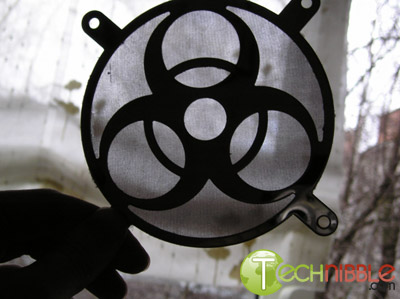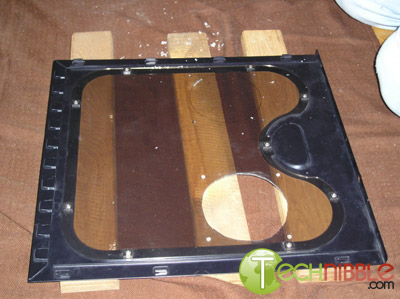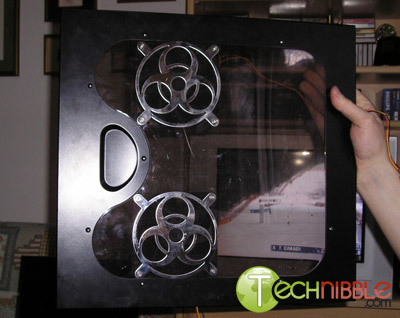Case Cooling – The Physics of Good Airflow
Clean sweep of the area
Even with all your good intentions, you’re liable to get dust coming in through all your intakes. Unless the computer is in a cleanroom, you definitely will get dust inside. Or, as it more commonly happens, something that can be described as computer mud – a very nasty mixture of dust and air moisture. The usual spots you’ll find dust in is all across the motherboard and cards, while computer silt usually sticks to fans themselves, sometimes clogging the bearings. What usually helps is a regular cleaning schedule. Every three months, you versus the computer at the CPU corral. It’s unplugged from the power outlet, armed with dust, silt and the occasional cobweb. You’re packing a can of WD-40, a roll of dry paper towels, a stiff dry brush, a low-powered vacuum cleaner, hair-dryer or compressed air can and a chocolate bar. The WD-40 is there as a temporary solution for whirring fans, the dry paper towels and dry brush are for wiping the fan blades. The vacuum cleaner (turned to blow, not vacuum), hair-dryer (set to cold) or compressed air can are for cleaning the interior – the vacuum cleaner has to be low-powered so as not to generate static electricity. And the chocolate bar? It’s for you, during a well-deserved cleaning break. Substitute with your favorite drink or snack – just keep it away from the PC so your machine doesn’t give up on the blue smoke all components are said to run on. Once the blue smoke comes out of the chips, they’ll never work again.
Syphoned filters
Another thing you might want to consider is filtering your intake. While it might create a bit of drag by slowing down the rate of flow, it will keep some of the dust trapped on the filter. This is usually not recommended on front intakes, since they’re hard to dismount, and thus hard to clean. However, if you have fans on the side panels, filtering them will make sure at least part of your air is clean, perhaps even removing the need for the front fan. Filters are commercially available, but using some thinner open-cell foams, such as ones from motherboard or card packagings, or even nylon stockings – you’d be surprised how many 120mm fans you can cover with a single stocking. Don’t ask me how to purchase those, though… Speaking of filters, while you’re at it, get a nice cover bezel for the fan, like a Biohazard or CounterStrike one, if it strikes your fancy. For the added efficiency and effect, if you have the proper tools, turning a perforated side-panel hole into a circular one (with fan mount holes intact, of course) you’ll gain on airflow. In the end, you’ll just have to clean it once-a-day, it’s just like brushing teeth, except the computer won’t smell any nicer.



Alternatives
Naturally, air cooling isn’t the only solution. There are several other solutions, which, while more efficient, also cost lots more. Examples of different cooling systems are:
- Water cooling – efficient, somewhat cumbersome, and requires a bit of space outside the case. Costs twice as much as an air solution, and needs a good deal of patience in order to assemble properly.
- Oil cooling – stable and silent, but it needs an impermeable chassis with all exits plugged and about 10 liters of motor oil – cooking oil can lead to a group of bacteria rebuilding a civilization on your motherboard. Not for the faint of heart or those not used to some heavy-duty DIYing it.
- Thermoelectric cooling – often called TECs or Peltier coolers, these technological wonders use electricity to draw heat away from the cooled component – the exact opposite effect of a digital thermometer. The drawback is their relatively high price, as well as the fact your power company will love you for using more electricity.
The moral of the story is, if you’re on a tight budget, you’ve got a creative spark and a fair amount of time, give your case a cleanup every now and then, and be creative with your cooling. Experiment with different setups of fans and see what fits you the most. Even though it’s relatively cheaper, well-planned air cooling can go a long way.
Special thanks to Hrvoje B (-rus-) for photographical documentation
Written by Boris M
Session expired
Please log in again. The login page will open in a new tab. After logging in you can close it and return to this page.

Very good advice Thanx
Excellent write-up!`
keep up the good job.
Some nice tips, I however have tried both and even though I have to take a duster biweekly(really I am overdoing it once a month would be fine) a negitive pressure system provides a lot more cooling.
[…] either be permeable or sealed, depending on whether the case has intake and exhaust holes or not. Continued… There’s more info there, I just don’t feel write copying an entire article :P […]
[…] shiny lights and added workload on your PSU. EDIT: This should be a good starting point. Enjoy.
edie cables?
whoever still use these?
sata-2 ftw.
Sam, if you look at the date this article was written in 2006 so at that time, most people did.
Hey thanks,
My old 120mm front fan stopped working ages ago. Had problems with CPU going up to 100C
I just realized why it happened
Air coming out of the back an no air getting sukced in the front. So that means the Heat is staying in the Case. Isnt it?
Thanks I will order a new 120mm fan for front asap.
Should work according to Theory.
Jesse
[…] Case cooling – the physics of good airflow | Technibble […]
Thanks for writing this article! Thanks to you my airflow will is better, thanks!
We loved your writing, please keep putting out more content like this!